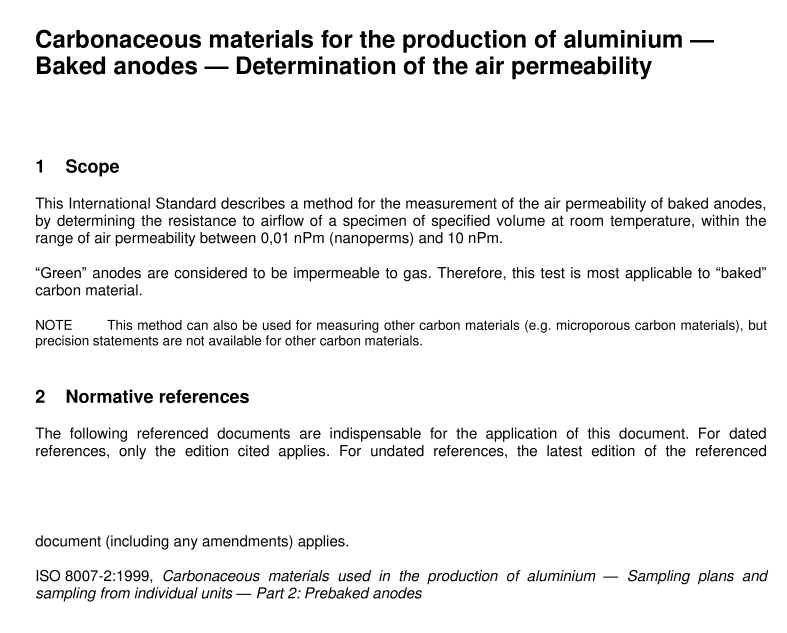BS ISO 15906 pdf download

BS ISO 15906 pdf download Carbonaceous materials for the production of aluminium — Baked anodes — Determination of the air permeability
Scope
This International Standard describes a method for the measurement of the air permeability of baked anodesby determining the resistance to airflow of a specimen of specified volume at room temperature, within therange of air permeability between 0,01 nPm (nanoperms) and 10 nPm.
“Green” anodes are considered to be impermeable to gas. Therefore, this test is most applicable to “bakedcarbon material.
NOTEThis method can also be used for measuring other carbon materials (e.g. microporous carbon materials), butprecision statements are not available for other carbon materials.
Normative references
The following referenced documents are indispensabl for the application of this document. For datedreferences. only the edition cited applies. For undated references, the latest edition of the reterenced
document (including any amendments) applies.
SO 8007-2:1999, Carbonaceous materials used in the production of aluminium – Sampling plans andsampling from individual units – Part 2. Prebaked anodes
3Terms and definitions
For the purposes of this document, the following terms and definitions apply
3.1
sample
portion of carbon from a baked anode
3.2
test specimen
article prepared from a sample
Principle4
The air permeability of a sampl is determined by a comparative method. The time necessary to draw aspecified volume of air through the test specimen is measured, This time is compared to the time necessary todraw a specified volume of air through a standard with known air permeability. This comparison yields the airpermeability of the sample material.
5Apparatus
5.1Callipers, with 0,01 mm reading precision.
5.2 Air permeability unit equipped as in 5.2.1 to 5.2.3. 5.2.1 Membrane vacuum pump, with an inlet to generate vacuum down to 1 00 mbar, and an outlet to generate high pressure up to 4 bar. The maximum flow rate has to reach 25 l/min.
5.2.2 Permeability cell, as shown in Figure 1 . The cell is designed to ensure an airtight sealing around the periphery of the sample. A rubber tube is forced as a seal against the cylindrical test specimen by means of compressed air. The porous filter-paper and the sponge-rubber protect the vacuum pump from particles and/or dust from the sample.
5.2.3 U-tube manometer, with light fork sensors as shown in Figure 2. The U-tube is directly linked with the vacuum pump and is placed parallel to the permeability cell. It has a working length of 220 mm, an internal diameter of 1 6 mm ± 1 mm and an external diameter of 20 mm. It is filled to the equilibrium mark with a non-volatile, non-hygroscopic liquid of low viscosity and density, such as dibutylphtalate or a light-grade mineral oil. Thereby, the vacuum and the air volume flowing through the test specimen can easily be measured by following the oil level inside the U-tube.









